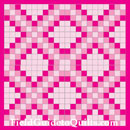
| FieldGuidetoQuilts.com | |
 |
Double & Triple Irish Chains |
 Double Irish Chain Double Irish Chain Double Irish Chain Double Irish Chain Triple Irish Chain Triple Irish Chain Irish Chain (Small) Irish Chain (Small) Triple Irish Chain (Large) Triple Irish Chain (Large) Triple Irish Chain Triple Irish Chain Sara's Favorite Sara's FavoriteComing soon:  Aunt Mary's Double Irish Chain Aunt Mary's Double Irish Chain |
